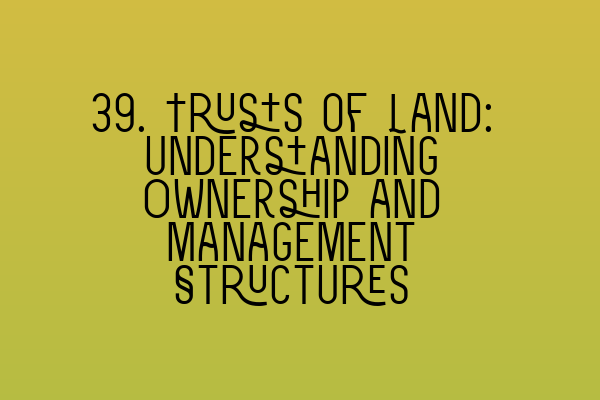39. Trusts of Land: Understanding Ownership and Management Structures
When it comes to property law and land law, understanding the complexities of ownership and management structures is crucial. One area that often requires attention is Trusts of Land. In this blog post, we will delve into the details of trusts of land and provide you with a comprehensive understanding of ownership and management structures.
What is a Trust of Land?
A Trust of Land is a legal arrangement where a property is held by one or more individuals (called trustees) for the benefit of others (called beneficiaries). The trustees have legal ownership of the property but are obligated to manage it for the benefit of the beneficiaries. Trusts of land can be established through various means, such as written agreements, wills, or court orders.
Types of Trusts
There are several types of trusts that fall under the category of Trusts of Land:
- Bare Trust
- Discretionary Trust
- Fixed Trust
- Resulting Trust
- Constructive Trust
- Lifetime Trust
Each type of trust has its own specific characteristics and purposes. Understanding the differences between them can help you determine which trust is most suitable for your specific situation.
Ownership Structures
A key aspect of Trusts of Land is the ownership structure. There are various ownership structures that can be employed in trusts, such as:
- Joint Tenancy
- Tenancy in Common
- Beneficial Joint Tenancy
- Equitable Joint Tenancy
- Partnership Ownership
Each ownership structure has its own implications and should be carefully considered when setting up a trust. It’s essential to understand the legal consequences and obligations associated with each structure.
Management Structures
In addition to ownership structures, trusts of land also require a clear management structure. The management structure determines the decision-making processes and responsibilities within the trust. Common management structures include:
- Trusteeship
- Directorship
- Committee
- Administratorship
Each management structure has its own advantages and disadvantages. Assessing the specific needs and goals of the trust can help determine the most appropriate management structure to ensure effective and efficient management.
Legal Considerations
When dealing with Trusts of Land, it is crucial to consider the legal aspects involved. This includes understanding the legal framework, compliance with relevant legislation, and ensuring the necessary legal documentation is in place. Professional legal advice and assistance are often required to navigate the complexities of Trusts of Land and ensure compliance with the law.
At SQE Property Law & Land Law, we offer expert legal services for Trusts of Land. Our team of experienced solicitors can guide you through the intricacies of ownership and management structures, ensuring your trust is properly established and managed.
For more information on SQE exams, we recommend checking out our related articles:
- SQE 1 Practice Exam Questions
- SQE 1 Practice Mocks FLK1 FLK2
- SQE 2 Preparation Courses
- SQE 1 Preparation Courses
- SRA SQE Exam Dates
Contact us today to discuss your Trusts of Land requirements and receive expert legal advice tailored to your specific needs.
